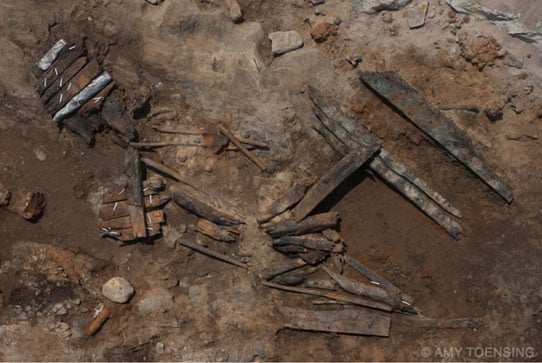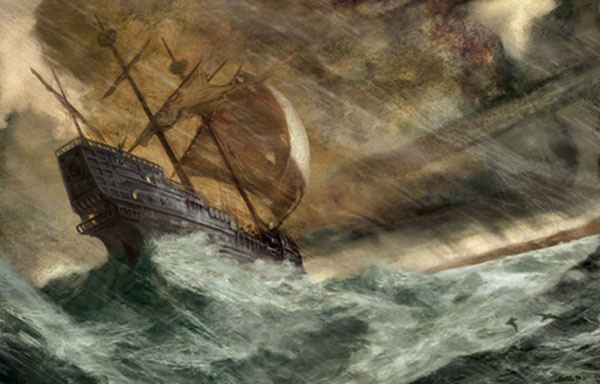The Misfortune of the Bom Jesus, the Diamond Shipwreck
The so-called Age of Discovery in Europe began in the early 15 th century, and produced numerous well-known explorers such as Vasco da Gama, Ferdinand Magellan, and Christopher Columbus. But there were countless others who lost their lives undertaking their perilous journeys, and as a result, became lost to the pages of history. Nevertheless, the discovery of shipwrecks, lying like skeletons on the ocean floor, resurrects the stories of these long-forgotten explorers, as researchers attempt to piece together the events of their voyage and the circumstances in which they met their final fate.
One such example is the ‘Diamond Shipwreck’. This was a shipwreck discovered in the sands of the Sperrgebiet (meaning ‘Prohibited Area’ in German), which is the rich and off-limits De Beers diamond-mining lease near the mouth of the Orange River on Namibia’s southern coast. In 2008, a company geologist working in the mining area U-60 came across what seemed to be a perfectly half sphere of rock. After picking up this rock and having a closer look at it, he realized that it was actually a copper ingot. On its weathered surface was a peculiar trident-shaped mark, which turned out to be the hallmark of Anton Fugger, one of Renaissance Europe’s wealthiest financiers.

The Diamond Shipwreck. Copyright: Amy Toensing
Archaeologists would eventually find an immense amount of these ingots beneath the sands (22 tonnes in total!), along with weapons, armour, bronze canons, canon balls, pewter bowls, ivory tusks, and of course gold. The gold was in the form of coins, more than 2,000 in total, mainly Spanish excelentes bearing the likenesses of the monarchs Ferdinand and Isabella, but also some Ventian, Moorish, French and other coinage. As the shipwreck was in the middle of one of the world’s most jealously guarded diamond mines, it is little wonder that its contents had been safe from treasure hunters all this time.

One of the coins uncovered in the Diamond Shipwreck. Copyright: Amy Toensing
More interestingly, for archaeologists at least, is the ship itself (along with some of the less sparkly artefacts). The ship itself is an East Indiaman from Portugal, and is dated to the 1530s. These were the ships used by traders during the Age of Discovery to bring exotic goods from Asia back to Europe, and brought great wealth to their respective nations. Despite the importance of these ships, there is much that is unknown about them, as the ‘Diamond Shipwreck’ is said to be only the second East Indiaman ever excavated by archaeologists. Therefore, this discovery will be able to give archaeologists new insights into the technical aspects of the ship, from its hull design, rigging, and even the way they evolved over time. Furthermore, as the cargo of this ship is intact, it enables archaeologists to piece together what life was like onboard a trading vessel, including the way food was cooked on the ship and the things that were brought by the explorers.
No story is complete, however, without actors. Based on the available clues, it has been suggested that the ‘Diamond Shipwreck’ was once a ship called the Bom Jesus (Good Jesus). This ship was captained by a Dom Francisco de Noronha, and carried around 300 sailors, soldiers, merchants, priests, nobles, and slaves. There has also been some speculation about the fate of these men. For a start, the only human remains recovered from the wreck are several toe bones in a shoe found pinned beneath a mass of timbers. Furthermore, few personal belongings were among the artefacts. Thus, archaeologists believe that many on board the ship managed to make it to dry land. Nevertheless, the harsh conditions of the land may have killed them off, as it was a barren wasteland that stretched for hundreds of kilometres, and it was winter. On the brighter side, the Orange River lay about 25 kilometres to the south of the shipwreck, and the castaways may have made it there. Moreover, the Portuguese might have met natives, as winter was the season when indigenous tribes ventured along the shore in search of the carcasses of southern right whales that were occasionally washed ashore. In short, it appears that we will never know the final fate of these adventurers.
Featured image: Artist’s depiction of an ancient ship in trouble. Art by Jon Foster
By Ḏḥwty
References
Bryson, D., 2014. Shipwreck Off Namibia is 500-year-old Treasure Trove. [Online]
Available at: http://abcnews.go.com/Technology/story?id=4773111
NBC News, 2014. 10 Shipwrecks that Capture Our Imagination. [Online]
Available at: http://www.nbcnews.com/id/29186405/ns/technology_and_science-science/t/shipwrecks-capture-our-imaginations/#.U49y_fldWSo
Smith, R., 2009. Diamond Shipwreck. [Online]
Available at: http://ngm.nationalgeographic.com/2009/10/shipwreck/smith-text
Smith, R., 2009. Namibia's Diamond Shipwreck. [Online]
Available at: http://www.thebigwideyonder.com/clippings/namibias-diamond-shipwreck/
The Telegraph, 2008. 500-year-old Shipwreck Found by Diamond Firm. [Online]
Available at: http://www.telegraph.co.uk/news/worldnews/1915703/500-year-old-shipwreck-found-by-diamond-firm.html



















